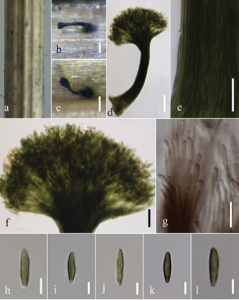Alfaria avenellae C.G. Lin & K.D. Hyde, sp. nov., Index Fungorum number: IF 553588
Etymology: In reference to the host genus, Avenella.
Holotype: MFLU 16-2657.
Saprobic on stems of Avenella sp. Asexual morph: Stroma absent. Setae absent. Synnemata scattered, erect, straight or slightly flexuous, dark green, mostly swollen at the base and apex, without a setose fringe, 180–345 μm ( x̅ = 259 μm, n = 12) long, 23–75 μm ( x̅= 40 μm, n = 12) wide at the base, 16–35 μm ( x̅= 25 μm, n = 12) wide at the middle point, 17–74 μm (x̅ = 53 μm, n = 12) wide at the apex. Conidiophores macronematous, synnematous, septate, unbranched or branched, straight or flexuous, smooth, thin-walled, green to dark green, up to 350 μm long, 1.3–2.6 μm wide. Conidiogenous cells phialidic, terminal, integrated, smooth, obclavate or cylindrical, hyaline to pale green at the upper part, pale green to green at the lower part, 6–26.5 μm long, 1.2–2.2 μm wide. Conidia aggregated in large, dark green masses, acrogenous, simple, oval, ellipsoidal or fusiform, smooth, thin-walled, aseptate, pale green to dark green, 7.5–13.5 μm ( = 10.6 μm, n = 60) long, 1.9–3.7 μm ( = 2.7 μm, n = 60) wide at the broadest part. Sexual morph: Undetermined.
Culture characteristics: Conidia germinating on MEA within 24 h. Colonies on MEA effuse, white from above,
light yellow from below, reaching a diameter of 0.8–2 cm in 6 months at 25 °C.
Material examined: ITALY. Forlì-Cesena Province: Fiumicello-Premilcuore, on a dead stem of Avenella sp.,
December 2014, Erio Camporesi, IT 2307 (MFLU 16-2657, holotype; HKAS 97449, isotype), ex-type living culture
MFLUCC 15-0828, KUMCC 17-0028.
Notes: Alfaria avenellae, which was collected from decaying culms of Avenella sp. in Italy, is the second Alfaria
species reported in Italy. The first species, A. spartii Senan., was described from a dead branch of Spartium junceum L. in Italy and can be distinguished from other sexual Alfaria species by having large, oval ascospores with distinctly periphysate ostioles (Hyde et al. 2016). Alfaria avenellae (MFLUCC 15-0828) forms a separate clade in the MP tree generated from combined aligned dataset, as well as the single gene ITS sequence data. It can be distinguished from other Alfaria species by having distinct synnemata, long conidiophores and pale green to dark green conidia. Other Alfaria spp. have conidiomata that are simple, myrothecium-like or sporodochial, conidiophores are short (up to 70 μm) and conidia are hyaline. Based on phylogenetic inference supported by morphological observations, we introduce this species as a new Alfaria species.
FIG 2. Alfaria avenellae (MFLU 16-2657, holotype) a Host material. b, c Synnemata on the host surface. d–f Synnemata, conidiophores and conidia. g Conidiogenous cells and conidia (Note: treated with 5% KOH). h–l Conidia. Scale bars: b, c = 100 μm, d = 50 μm, e, f = 20 μm, g = 10 μm, h–l = 5 μm.

